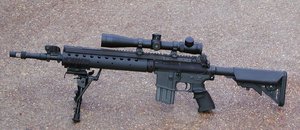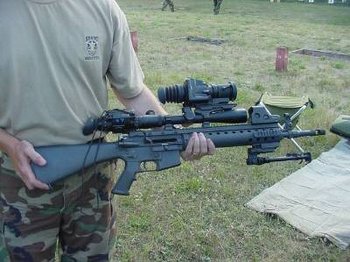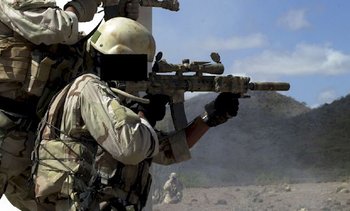United States Navy Mark 12 Mod X Special Purpose Rifle
|
|
The United States Navy Mark 12 Mod 0/1 Special Purpose Rifle (SPR) is a rifle that has been in service with the United States special forces in Operation Enduring Freedom and Operation Iraqi Freedom. SPR initially stood for Special Purpose Receiver, but that nomenclature seems to have disappeared as the weapon became a stand alone weapon system, and not just an add on upper as part of proposed SOPMOD upgrades. SPR now means Special Purpose Rifle. It was eventually type classified by the Navy as the Mk 12, though the Army also uses this designation.
| Contents |
Background
This weapon system is a heavily modified deviation from the familiar AR15/M16 line of infantry weapons, and thus is chambered for NATO standard 5.56 x 45 mm (SIMILAR to .223 in Remington) caliber ammunition. It serves a light sniper/sharpshooter role. The SPR was originally proposed by Mark Westrom, currently President of Armalite, while at the Rock Island Arsenal. The SPR program was an outgrowth of the desire by both US Army and Navy special forces for a rifle with greater effective range than an M4 type Carbine but still shorter in length than a standard issue M16A2/A4. The SPR program appears to have grown out of both the death of the proposed SOPMOD Block IV, and the US Navy SEALs 'Recon Rifle' (A 16" flat-topped AR-15/M16 Carbine). The Naval Surface Warfare Center, Crane Division (often referred to as NSWC-Crane or just Crane), essentially expanded on the Recon Rifle, an idea the SEALs maintain was a waste of energy and money.
The exact history of the Mk 12 is still something under debate, but its become apparent that there are between 4 and 5 prime iterations of the weapon, culminating in the final Mk 12 Mod 1 version. One progression has four models: SPR Proto 1, SPR Proto 2, Mk 12 Mod 0 and Mk 12 Mod 1. The other progression is: SPR, SPR/A, SPR/B, Mk 12 Mod 0, and Mk 12 Mod 1 (all as separate iterations). The specifications entered will follow the second progression.
Though the Mark 12 Mod 0 Special Purpose Rifle has enjoyed relative obscurity in its short life, recently it has been featured prominently both in media photos of the Iraq conflict and in interactive video games such as the government-created title America's Army: Special Forces and the console title Tom Clancy's Ghost Recon 2.
Specifications
- Upper Receiver: The upper receiver blocks themselves were initially supplied by Colt, with some of those being from Diemaco as well (Colt has been outsourcing parts of its production to the Canadian firm for a while now). There is a debate about whether the upper blocks for the Mk 12 rifles, though, came solely from Armalite, or were a mix of receivers from Armalite and Colt/Diemaco. All of these upper receivers were flat top, but have been seen both with the old style tear drop forward assist and the new round style. There is, however, no obvious consistency in this regard.
- Lower Receiver: When the SPR program was still in the phase where it was just a receiver, Crane assembled all of its protos using either M16A1 or M4A1 lowers. It is unknown whether or not this pattern continued as the program progressed. There is also some issue about whether or not when the Navy type-classified the weapon, that Precision Reflex International - PRI, began assembling the rifles themselves.
- Barrel: A 18 in (457 mm) threaded-muzzle match-grade free floating stainless steel heavy barrel with a 1:7 in (178 mm) rifle twist ratio. The barrels have a special contour to maximize accuracy and minimize weight; they are manufactured by Douglas Barrels. An OPS Inc. Muzzle Brake and collar (to align the Ops Inc. 12th Model Suppressor) is installed with the barrel. These barrels were designed to take advantage of the new 77 grain Mk 262 cartridge that is now being fielded.
- Buttstock: SPRs in action have been seen with M16A1 buttstocks, M16A2 buttstocks, retractable M4 buttstocks, and the Crane Enhanced retractable buttstock. It is readily compatible with any type of stock system developed for the AR-15 weapon system.
- Handguards: In all cases a free floating forearm is utilized. This handguard does not ever touch the barrel, increasing the accuracy of the weapon by removing increased vibration exerted on the barrel by the rest of the gun. The first SPRs use a PRI Gen I or Gen II carbon-fiber free-float tubes. The SPR/A, SPR/B, and Mk 12 Mod 1 all use the Knights Armament Company - KAC M4 Match Free-Floating RAS (Rail Adapter System). The Mk 12 Mod 0 uses PRI Gen III free-float tubes. The Gen I and Gen II Freefloat Forearms are combined with the Atlantic Research Marketing Systems (ARMS) #38 SPR MOD Sleeve, while the Gen III Freefloat Forearm, due its it larger barrel nut, only works with the ARMS #38 SPR PEQ-2-3.
- Sights: The original SPR used an early PRI flip-up front sight with an elevation dial, that has since been discontinued. The Mk 12 Mod 0 uses the current PRI flip-up front sight. The SPR/A, SPR/B, and Mk 12 Mod 1 use the KAC rail foreend flip-up front sight. The SPR and Mk 12 Mod 0 use the ARMS #40 flip up rear sight. The rest of the models use the KAC 600-Meter flip up rear.
- Optics: Due to the relative modularity of the system, optics (as well as almost everything else) can be mounted per the operator's wishes, however, this weapon system is most often seen with a 3.5-10x40mm Leupold LR M3 (SPR/A), 2.5-9x36mm TS-30 (SPR/B), or 3-9x36mm TS-30 A2 (Mk 12 Mod 0/1) Mid Range/Tactical Illuminated Reticle Dayscope (civilian versions are known as the Leupold Mark 4 MR/T 3-9x36). Night vision devices can also be attached. These scopes usually come with flip open dust covers and a honeycomb anti-glare anti-reflection device (ARD).
- Mounts: As mentioned before, a long accessory rail, called a SWAN Sleeve (ARMS SPR MOD or ARMS #38 SPR PEQ-2-3), manufactured by ARMS, is installed, running the length of the rifle. The SPR/A and SPR/B both used the KAC M4 Match FF RAS. Two ARMS #22 Throwlever 30 mm steel rings are used to mount the dayscope. The SPR/A, SPR/B, and Mk 12 Mod 1 use ARMS #22 high rings, while due to the increased height form the SWAN Sleeve, the SPR and Mk 12 Mod 1 use ARMS #22 medium rings. An under-the-handguard ARMS #32 Throwlever mount is used to quick release mount the Harris bipod (the ARMS #42 Throwlever mount is used to mount the Versa-pod.)
- Bipod: Originally Versa-Pods, a cheaper Chinese-made copy of the relatively expensive Parker-Hale swivel bipod, were used, but were taken off the system after the initial SPR. Currently, a Harris swivel model bipod is typically used with the SPR, and is sometimes seen with a KMW Pod-Loc tension adjustment device. As mentioned above, the bipod is mounted via a ARMS #32 throwlever device attached to the bottom rail of the rifle's forearm. The ARMS mount is used on both Mod 0 and Mod 1.
- Suppressor: The suppressor threads directly onto the OPS Inc. Muzzle Brake and uses the collar to stay centered. It is an OPS Inc. 12th Model SPR Muzzle Brake Suppressor (MBS).
- Ammunition: The SPR is not used to fire standard issue M855 ball or M856 Tracer (and even less so M193 ball). Due to the limits in performance and poor accuracy of the 62 grain (4 g) M855 ball (standard NATO green-tip .223), the Mark 262 Open Tip match (OTM) round was developed as a more accurate 5.56 x 45 mm round. The cartridges are made by Black Hills Ammunition. The first productions were designated the Mk 262 Mod 0 and used a Sierra MatchKing 77 grain (5 g) Hollow Point Boat Tail (HPBT) bullet without a cannelure (crimping groove). Black Hills then approached Nosler, who made a similar 77gr OTM bullet, and Nosler agreed to supply cannelured bullets to Black Hills. This load was designated Mk 262 Mod 1. Recently, Sierra agreed to add a minimal crimp to their bullet, and this has since replaced the Nosler bullet in the current versions of Mk 262 Mod 1.
Photos
| Missing image SPR-A_Profile.jpg An SPR/A w/ fixed stock, Harris bipod, and the KAC M4 Match FF RAS. | Missing image SPR-B_Profile.jpg An SPR/B setup similarly to the SPR/A to the left. The SPR/A and SPR/B only differ on the type of scope used. |
| Missing image Spr_sf_p5.jpg Another US Army SF operator carrying is OD green painted Mk 12 Mod 0. The exposed front end of the rifle details the OPS Inc. muzzle brake, the Versa-Pod bipod (folded) and an Insight Technologies AN/PEQ-2A illuminator mounted on the side of the handguards. | |
| Missing image Spr_sf_p2.jpg A US Army SF operator shows his Filipino counterparts the SPR. This one also has a full M16 riflestock, has the OPS Inc. silencer attached, and is camouflage painted. | |
| Missing image Mk12_Mod0_Profile.jpg An SPR, not a Mk 12 Mod 0. Note the early PRI freefloat tube of constant diameter. This SPR has a Versa-pod bipod and has a fixed stock. The upper receiver block has a teardrop-shaped forward assist. | |
See also
- United States Navy Mark 11 Mod 0 Sniper Weapon System
- SEAL Recon Rifle
- Knight's Armament Company
- KAC SR-25
External links
- AR15.com (http://www.ar15.com/)
- Mid-South Tactical Network (http://www.mstn.biz/)
- Atlantic Research Marketing Systems, Inc. (http://www.armsmounts.com/)
- Sierra Bullets (http://sierrabullets.com/)
- OPS, Inc. Muzzle Brakes and Suppressors (http://opsinc.us/)



